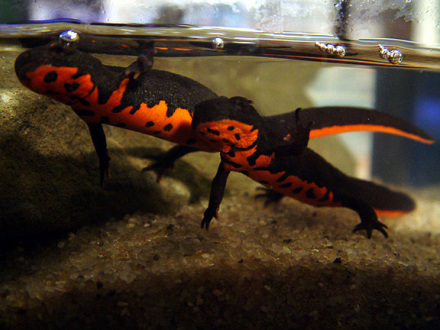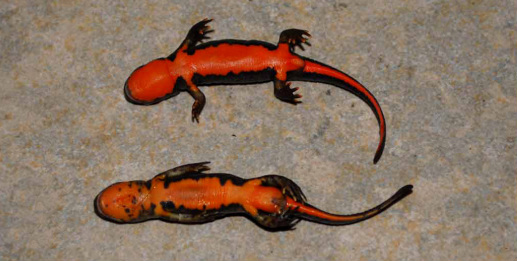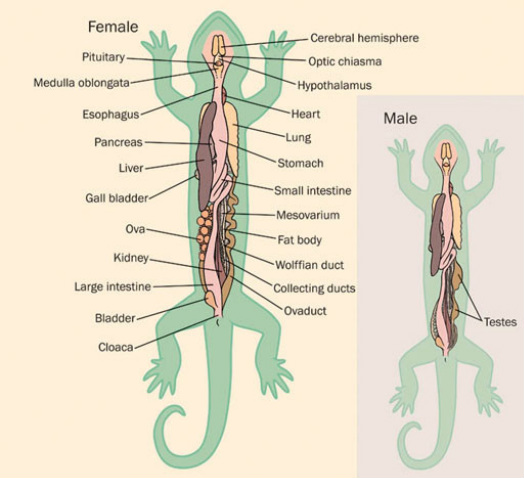Fire Belly Newt
Common names: There are two kinds of Fire-Bellied Newt that are readily available
in the pet trade :
Japanese Fire-Bellied Newt : Cynops pyrrhogaster
Chinese Fire-Bellied Newt : Cynops Orientalis
The Chinese Fire-bellied Newt may sometimes also be referred to as the Oriental Fire-Bellied Newt or the Dwarf Fire-Bellied Newt .
Description : Fire-Bellied Newts are usually dark brown to black with red or orange
undersides, hence the name Fire-Bellied. The Japanese Fire-Bellied
Newt is larger than the Chinese Fire-Bellied Newt and they tend
to have red speckled bellies. They have rough skin, while the Chinese
Fire-bellied Newts have smooth skin and a speckled orange
underside.
Size : Japanese Fire-Bellied Newts average at about 9-12 CM (3.5-5 inches), while
Chinese Fire-Bellied Newts will only grow to 6-10 CM (3-4 inches).
Life span : Fire-Bellied Newts can live up to 30 years with appropriate care, but
average at about 10-15 years generally.
Origin : Japanese Fire-Bellied Newts are native to Japan on the Islands of Honshu,
Kyushu and Shikoku.
in the pet trade :
Japanese Fire-Bellied Newt : Cynops pyrrhogaster
Chinese Fire-Bellied Newt : Cynops Orientalis
The Chinese Fire-bellied Newt may sometimes also be referred to as the Oriental Fire-Bellied Newt or the Dwarf Fire-Bellied Newt .
Description : Fire-Bellied Newts are usually dark brown to black with red or orange
undersides, hence the name Fire-Bellied. The Japanese Fire-Bellied
Newt is larger than the Chinese Fire-Bellied Newt and they tend
to have red speckled bellies. They have rough skin, while the Chinese
Fire-bellied Newts have smooth skin and a speckled orange
underside.
Size : Japanese Fire-Bellied Newts average at about 9-12 CM (3.5-5 inches), while
Chinese Fire-Bellied Newts will only grow to 6-10 CM (3-4 inches).
Life span : Fire-Bellied Newts can live up to 30 years with appropriate care, but
average at about 10-15 years generally.
Origin : Japanese Fire-Bellied Newts are native to Japan on the Islands of Honshu,
Kyushu and Shikoku.
Breeding : Breeding Fire-Bellied Newts is quite simple, but not always successful.
Conditions need to be right to encourage Fire-Bellied Newts to breed and
they need to be cooled for around 50 days beforehand. Reduce both the
temperature and the light during the cooling period and aim to keep
them at around 10°C at this time. Reduce feeding to a minimum and
only feed items that won’t spoil in the water if left by your newts.After
the cooling period, bring the temperatures back up to around 20°C and
feed them well. This should replicate the conditions of spring and
encourage your newts to begin courtship. Males release pheromones to
attract the female and fertilization is internal. Around 100 – 200 eggs
will be spawned around the base of the aquatic plants. The adults
should be separated from the spawn as soon as possible to avoid them
eating the eggs. They will incubate for approximately 4-6 weeks before
hatching. The newly hatched larvae are fully aquatic can be fed on
finely chopped earthworms of flaked fish food, until they
metamorphose at around 4-6 months, depending on the water
temperature. Juvenile fire-bellied newts live terrestrially (on land) for
1-3 years until they mature, then will return to the water to continue an
aquatic lifestyle.



